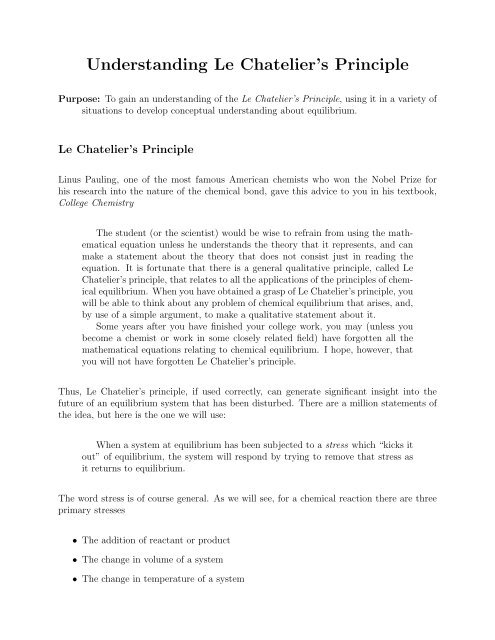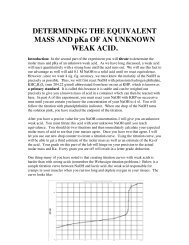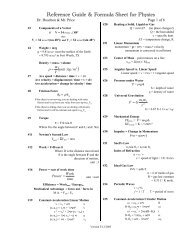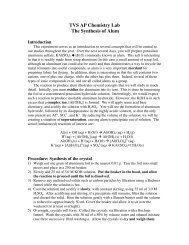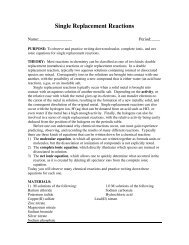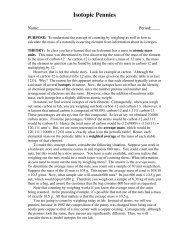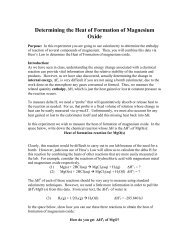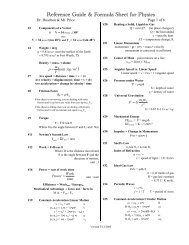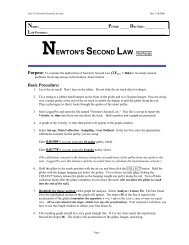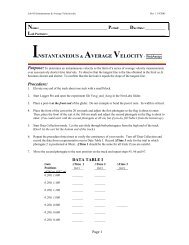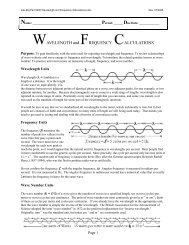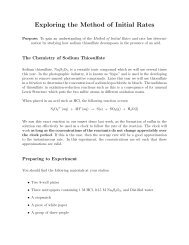Lab XI - Le Chatelier's Principle
Lab XI - Le Chatelier's Principle
Lab XI - Le Chatelier's Principle
- No tags were found...
You also want an ePaper? Increase the reach of your titles
YUMPU automatically turns print PDFs into web optimized ePapers that Google loves.
The following mini-experiments will allow you to observe equilibrium systems that have beenstressed so that you can apply <strong>Le</strong> Chatelier as part of the explanation to rationalize why thevarious systems behave the way they do.Preparing to ExperimentYou should find the following materials at your station• Several test tubes• Solutions of iron(III) nitrate, potassium thiocyanate, saturated sodium chloride, concentratedHCl, and 1.0 M NaOH• Distilled water• A capped syringe filled with butane• A colorimeter or spectrophotometerExpt. 1 - The condensation of butaneIn front of you, please find a 60 ml syringe that has been filled with butane from a lighter.Record the volume of the syringe, the temperature of the room, and the atmospheric pressurein the table below:Table 1: Equilibrium Data for the Butane SyringeInitial Volume of SyringeTemp. of RoomAtmospheric PressureVolume of Syringe needed to see liquidCarefully push the plunger down on the syringe as far as possible until you see some visiblechange. What change do you see?Write down the chemical reaction that describes the change seen above:Explain, in terms of <strong>Le</strong> Chatelier’s <strong>Principle</strong>, why you see the change you do.
Determine the volume needed to just observe a significant change in the syringe. Recordthis volume in table I above.Now, using information in Table I, estimate the equilibrium constant, K p , for the reactionabove. Justify your reasoning and include any calculations you deem necessary:Calculation of K p with reasoning:
Exploring the Equilibria of Saturated Sodium Chloride SolutionsObtain a large test tube and add a small volume of saturated sodium chloride solution.Describe what you see:Add 2 drops of concentrated hydrochloric acid to the solution. Describe any changes to thesolution:Write the chemical reaction that describes any changes you have observed above:Do you expect the value of K c for the reaction you have just written down to be greater than1 or less than 1? Explain.Explain, in terms of <strong>Le</strong> Chatelier’s <strong>Principle</strong>, why any change observed occurred.
Add several drops of distilled water to the solution and record any changes you see:Explain these changes, if any, that occurred using <strong>Le</strong> Chatelier’s <strong>Principle</strong>
Based on what you have learned this year, create a reasonable procedure to actually determinethe value of K c for the reaction written above. Discuss any data you would need tocollect and how you can use this data to obtain K.
The iron-thiocyanate equilibrium and <strong>Le</strong> Chatelier’s <strong>Principle</strong>As we saw in our last experiment, the thiocyanate ion, SCN − , can be used as a very sensitivetest for iron cations, as the following complexation occurs when the two are combined,resulting in a reddish-brown solution:Fe 3+ (aq) + SCN − (aq) ⇋ [Fe(SCN)] 2+ (aq)Create some of the complex ion by adding a few drops of iron(III) nitrate to a small amountof distilled water. Continuing adding until the solution is a light yellow-orange color. Thenadd several drops of potassium thiocyanate solution. What do you see?Now add several drops of 1.0 M sodium hydroxide to the solution. Describe any change thatoccurs.Does adding any addition potassium thiocyanate to this solution change its appearance? Ifso, describe any changes:
Now add several drops of 3.0 M HCl to the solution. Describe any changes that occurAdd a few more drops of iron(III) nitrate solution to the tube. Describe any changes thatoccur:Finally, add NaOH to the tube again. Describe any changes that occur.
Use <strong>Le</strong> Chatelier’s <strong>Principle</strong> to rationalize any changes you have seen.chemical equations where relevant.Include balanced
The effect of Temperature on the thiocyanate equilibriumCreate the iron-thiocyanate complex ion in a test tube. Dilute the solution such that it has alight red brown color. Take a small amount of this solution and place in a spectrophotometerthat is calibrated to read absorbance values at around 450 nm. Record the absorbance ofthe solution in the table below, along with the temperature of the solution. Place some ofthe solution into two different test tubes, and immerse one tube into ice water while theother tube is placed into boiling water. <strong>Le</strong>t the tubes rest in the different water baths forapproximately 10 minutes. After this time extract some of the solution from each tube andrecord both the temperature of the solution and its absorbance value at 450 nm.Table 2: Absorbance values for the iron-thiocyanate complex at different temperaturesTemp. of Solution (K) Absorbance of solution at 450 nmBased upon the data, is the complexation reaction endothermic or exothermic? Justify youranswer using <strong>Le</strong> Chatelier’s <strong>Principle</strong>.


